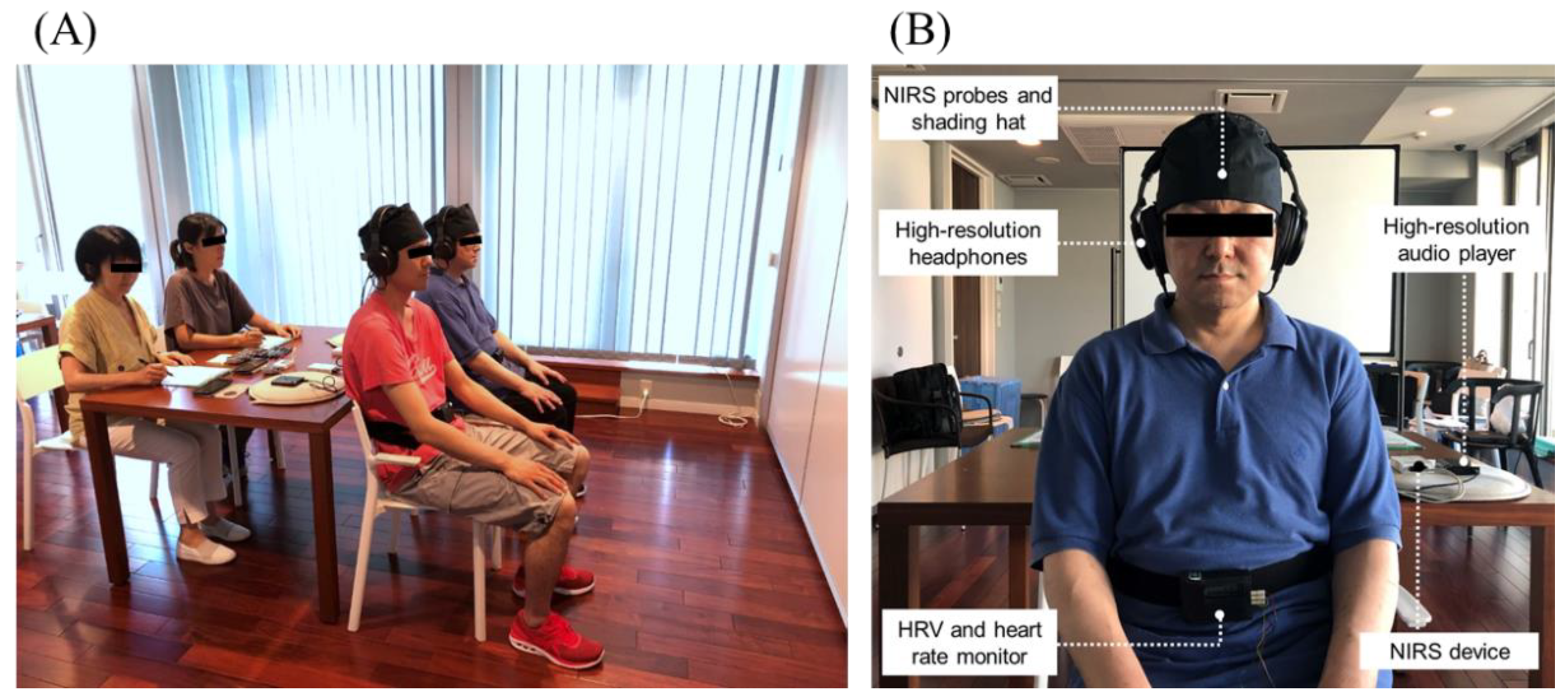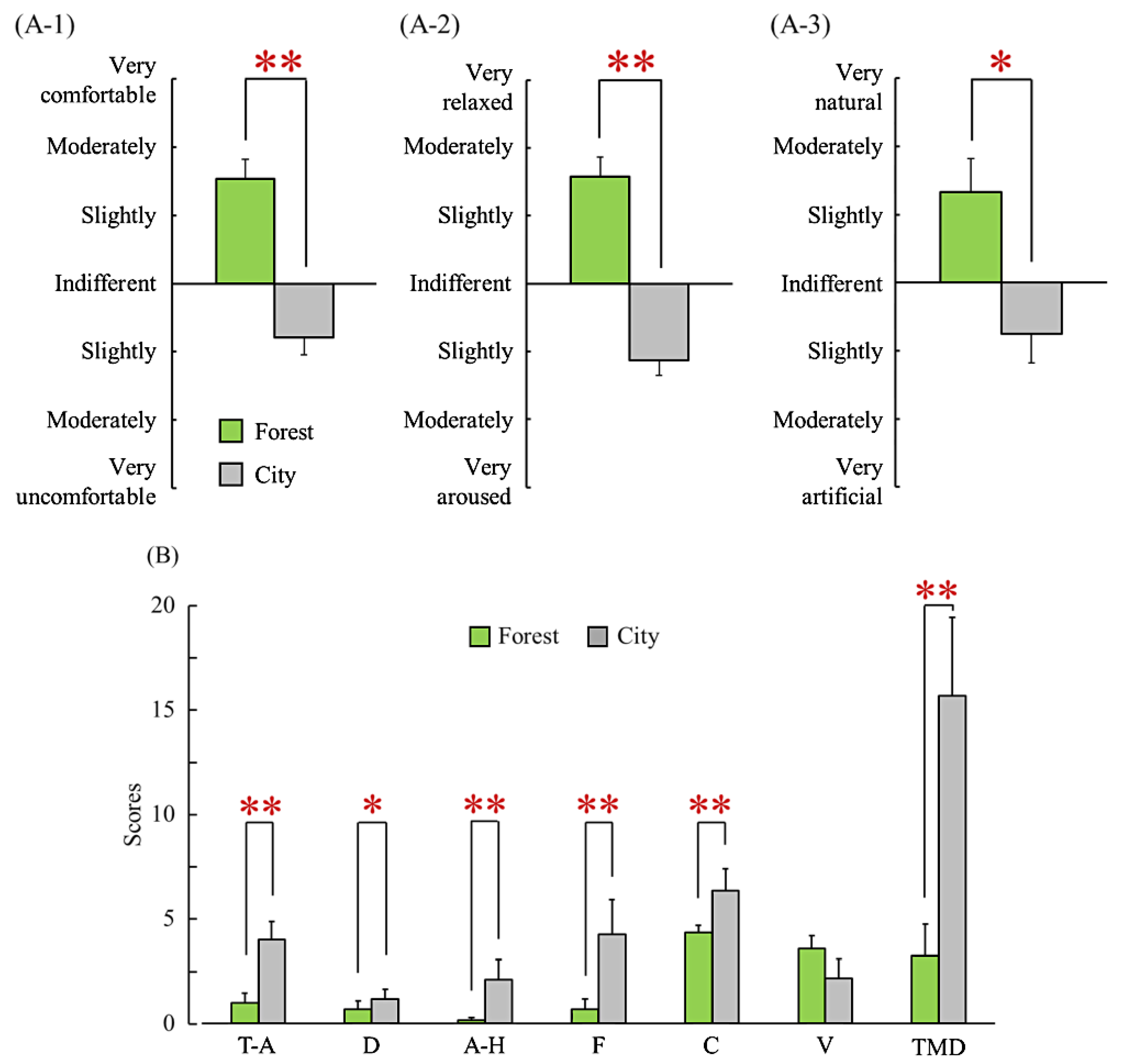Relaxing Effect Induced by Forest Sound in Patients with Gambling Disorder
Abstract
:1. Introduction
2. Materials and Methods
2.1. Participants
2.2. Auditory Stimulation
2.3. Study Protocol
2.4. Physiological Measurements
2.4.1. NIRS
2.4.2. HRV and Heart Rate
2.5. Psychological Measurements
2.6. Statistical Analyses
3. Results
3.1. Physiological Effects
3.1.1. NIRS
3.1.2. HRV and HR
3.2. Psychological Effects
4. Discussion
5. Conclusions
Author Contributions
Funding
Acknowledgments
Conflicts of Interest
References
- Sugiura, E. Five Things to Know about Japan’s New Casino Law. Nikkei Asian Review. 2018. Available online: https://asia.nikkei.com/Business/Business-trends/Five-things-to-know-about-Japan-s-new-casino-law2 (accessed on 3 January 2020).
- GGRASIA Japan Basic Plan on Gambling Addiction in Place by April. 2018. Available online: https://www.ggrasia.com/japan-basic-plan-on-gambling-addiction-in-place-by-april/ (accessed on 3 January 2020).
- Cowlishaw, S.; Merkouris, S.; Dowling, N.; Anderson, C.; Jackson, A.; Thomas, S. Psychological therapies for pathological and problem gambling. Cochrane Database Syst. Rev. 2012, 11, CD008937. [Google Scholar] [CrossRef] [PubMed]
- Asia News Network. Gambling Addicts to Gain Coverage in Japan. The Japan News. 2019. Available online: http://annx.asianews.network/content/gambling-addicts-gain-coverage-japan-110198 (accessed on 3 January 2020).
- American Psychiatric Association. Diagnostic and Statistical Manual of Mental Disorders, 5th ed.; American Psychological Association: Arlington, VA, USA, 2013. [Google Scholar]
- Kessler, R.C.; Hwang, I.; LaBrie, R.; Petukhova, M.; Sampson, N.A.; Winters, K.C.; Shaffer, H.J. DSM-IV pathological gambling in the National Comorbidity Survey Replication. Psychol. Med. 2008, 38, 1351–1360. [Google Scholar] [CrossRef] [PubMed] [Green Version]
- Rogier, G.; Picci, G.; Velotti, P. Struggling with happiness: A pathway leading depression to gambling disorder. J. Gambl. Stud. 2019, 35, 293–305. [Google Scholar] [CrossRef] [PubMed] [Green Version]
- Petry, N.M.; Kiluk, B.D. Suicidal ideation and suicide attempts in treatment-seeking pathological gamblers. J. Nerv. Ment. Dis. 2002, 190, 462–469. [Google Scholar] [CrossRef] [PubMed] [Green Version]
- Afifi, T.O.; Nicholson, R.; Martins, S.S.; Sareen, J. A longitudinal study of the temporal relation between problem gambling and mental and substance use disorders among young adults. Can. J. Psychiatry 2016, 61, 102–111. [Google Scholar] [CrossRef]
- Frumkin, H. Beyond toxicity: Human health and the natural environment. Am. J. Prev. Med. 2001, 20, 234–240. [Google Scholar] [CrossRef]
- James, P.; Banay, R.F.; Hart, J.E.; Laden, F. A review of the health benefits of greenness. Curr. Epidemiol. Rep. 2015, 2, 131–142. [Google Scholar] [CrossRef] [Green Version]
- Song, C.; Ikei, H.; Miyazaki, Y. Physiological effects of nature therapy: A review of the research in japan. Int. J. Environ. Res. Public Health 2016, 13, 781. [Google Scholar] [CrossRef]
- Hansen, M.M.; Jones, R.; Tocchini, K. Shinrin-Yoku (Forest Bathing) and nature therapy: A state-of-the-art review. Int. J. Environ. Res. Public Health 2017, 14, 851. [Google Scholar] [CrossRef]
- Lee, I.; Choi, H.; Bang, K.S.; Kim, S.; Song, M.; Lee, B. Effects of forest therapy on depressive symptoms among adults: A systematic review. Int. J. Environ. Res. Public Health 2017, 14, 321. [Google Scholar] [CrossRef]
- Jo, H.; Song, C.; Ikei, H.; Enomoto, S.; Kobayashi, H.; Miyazaki, Y. Physiological and psychological effects of forest and urban sounds using high-resolution sound sources. Int. J. Environ. Res. Public Health 2019, 16, 2649. [Google Scholar] [CrossRef] [PubMed] [Green Version]
- Takeuchi, H.; Tsurumi, K.; Murao, T.; Takemura, A.; Kawada, R.; Urayama, S.I.; Aso, T.; Sugihara, G.I.; Miyata, J.; Murai, T.; et al. Common and differential brain abnormalities in gambling disorder subtypes based on risk attitude. Addict. Behav. 2017, 69, 48–54. [Google Scholar] [CrossRef] [PubMed] [Green Version]
- Zois, E.; Kiefer, F.; Lemenager, T.; Vollstädt-Klein, S.; Mann, K.; Fauth-Bühler, M. Frontal cortex gray matter volume alterations in pathological gambling occur independently from substance use disorder. Addict. Biol. 2017, 22, 864–872. [Google Scholar] [CrossRef] [PubMed]
- Kuribayashi, R.; Nittono, H. High-resolution audio with inaudible high-frequency components induces a relaxed attentional state without conscious awareness. Front. Psychol. 2017, 8, 93. [Google Scholar] [CrossRef] [PubMed] [Green Version]
- Watanabe, Y.; Sumitani, S.; Hosokawa, M.; Ohmori, T. Prefrontal activation during two Japanese stroop tasks revealed with multi-channel near-infrared spectroscopy. J. Med. Investig. 2015, 62, 51–55. [Google Scholar] [CrossRef] [PubMed] [Green Version]
- Kobayashi, H.; Ishibashi, K.; Noguchi, H. Heart rate variability; an index for monitoring and analyzing human autonomic activities. Appl. Hum. Sci. 1999, 18, 53–59. [Google Scholar] [CrossRef] [Green Version]
- Kanaya, N.; Hirata, N.; Kurosawa, S.; Nakayama, M.; Namiki, A. Differential effects of propofol and sevoflurane on heart rate variability. Anesthesiology 2003, 98, 34–40. [Google Scholar] [CrossRef]
- Osgood, C.E.; Suci, G.J.; Tannenbaum, P. The Measurement of Meaning; University of Illinois Press: Urbana, IL, USA, 1957. [Google Scholar]
- Malouff, J.M.; Schutte, N.S.; Ramerth, W. Evaluation of a short form of the POMS-Depression scale. J. Clin. Psychol. 1985, 41, 389–391. [Google Scholar] [CrossRef]
- Hoshi, Y.; Kobayashi, N.; Tamura, M. Interpretation of near-infrared spectroscopy signals: A study with a newly developed perfused rat brain model. J. Appl. Physiol. 2001, 90, 1657–1662. [Google Scholar] [CrossRef] [Green Version]
- Park, B.J.; Tsunetsugu, Y.; Kasetani, T.; Hirano, H.; Kagawa, T.; Sato, M.; Miyazaki, Y. Physiological effects of shinrin-yoku (taking in the atmosphere of the forest)—using salivary cortisol and cerebral activity as indicators. J. Physiol. Anthropol. 2007, 26, 123–128. [Google Scholar] [CrossRef] [Green Version]
- Igarashi, M.; Ikei, H.; Song, C.; Miyazaki, Y. Effects of olfactory stimulation with rose and orange oil on prefrontal cortex activity. Complement. Ther. Med. 2014, 22, 1027–1031. [Google Scholar] [CrossRef]
- Miyazawa, T.; Horiuchi, M.; Komine, H.; Sugawara, J.; Fadel, P.J.; Ogoh, S. Skin blood flow influences cerebral oxygenation measured by near-infrared spectroscopy during dynamic exercise. Eur. J. Appl. Physiol. 2013, 113, 2841–2848. [Google Scholar] [CrossRef] [PubMed]
- Ochiai, H.; Ikei, H.; Song, C.; Kobayashi, M.; Miura, T.; Kagawa, T.; Li, Q.; Kumeda, S.; Imai, M.; Miyazaki, Y. Physiological and psychological effects of a forest therapy program on middle-aged females. Int. J. Environ. Res. Public Health 2015, 12, 15222–15232. [Google Scholar] [CrossRef] [PubMed] [Green Version]
- Song, C.; Ikei, H.; Kagawa, T.; Miyazaki, Y. Effects of walking in a forest on young women. Int. J. Environ. Res. Public Health 2019, 16, 229. [Google Scholar] [CrossRef] [PubMed] [Green Version]
- Tsunetsugu, Y.; Lee, J.; Park, B.J.; Tyrväinen, L.; Kagawa, T.; Miyazaki, Y. Physiological and psychological effects of forest landscapes assessed by multiple measurements. Landsc. Urban Plan. 2013, 113, 90–93. [Google Scholar] [CrossRef]
- Song, C.; Ikei, H.; Kobayashi, M.; Miura, T.; Taue, M.; Kagawa, T.; Li, Q.; Kumeda, S.; Imai, M.; Miyazaki, Y. Effect of forest walking on autonomic nervous system activity in middle-aged hypertensive individuals: A pilot study. Int. J. Environ. Res. Public Health 2015, 12, 2687–2699. [Google Scholar] [CrossRef] [PubMed] [Green Version]
- Potenza, M.N.; Balodis, I.M.; Franco, C.A.; Bullock, S.; Xu, J.; Chung, T.; Grant, J.E. Neurobiological considerations in understanding behavioral treatments for pathological gambling. Psychol. Addict. Behav. 2013, 27, 380–392. [Google Scholar] [CrossRef] [Green Version]
- Sung, J.; Woo, J.M.; Kim, W.; Lim, S.K.; Chung, E.J. The effect of cognitive behavior therapy-based “forest therapy” program on blood pressure, salivary cortisol level, and quality of life in elderly hypertensive patients. Clin. Exp. Hypertens. 2011, 34, 1–7. [Google Scholar]
- Reuter, J.; Raedler, T.; Rose, M.; Hand, I.; Gläscher, J.; Büchel, C. Pathological gambling is linked to reduced activation of the mesolimbic reward system. Nat. Neurosci. 2005, 8, 147–148. [Google Scholar] [CrossRef]
- Takahashi, T.; Takikawa, Y.; Kawagoe, R.; Shibuya, S.; Iwano, T.; Kitazawa, S. Influence of skin blood flow on near-infrared spectroscopy signals measured on the forehead during a verbal fluency task. Neuroimage 2011, 57, 991–1002. [Google Scholar] [CrossRef]
- Sato, H.; Yahata, N.; Funane, T.; Takizawa, R.; Katura, T.; Atsumori, H.; Nishimura, Y.; Kinoshita, A.; Kiguchi, M.; Koizumi, H.; et al. A NIRS-fMRI investigation of prefrontal cortex activity during a working memory task. Neuroimage 2013, 83, 158–173. [Google Scholar] [CrossRef] [PubMed]



© 2020 by the authors. Licensee MDPI, Basel, Switzerland. This article is an open access article distributed under the terms and conditions of the Creative Commons Attribution (CC BY) license (http://creativecommons.org/licenses/by/4.0/).
Share and Cite
Ochiai, H.; Song, C.; Jo, H.; Oishi, M.; Imai, M.; Miyazaki, Y. Relaxing Effect Induced by Forest Sound in Patients with Gambling Disorder. Sustainability 2020, 12, 5969. https://doi.org/10.3390/su12155969
Ochiai H, Song C, Jo H, Oishi M, Imai M, Miyazaki Y. Relaxing Effect Induced by Forest Sound in Patients with Gambling Disorder. Sustainability. 2020; 12(15):5969. https://doi.org/10.3390/su12155969
Chicago/Turabian StyleOchiai, Hiroko, Chorong Song, Hyunju Jo, Masayuki Oishi, Michiko Imai, and Yoshifumi Miyazaki. 2020. "Relaxing Effect Induced by Forest Sound in Patients with Gambling Disorder" Sustainability 12, no. 15: 5969. https://doi.org/10.3390/su12155969





